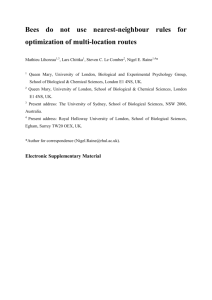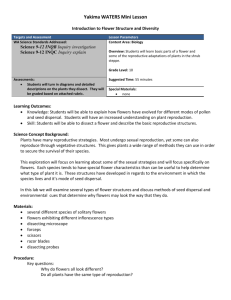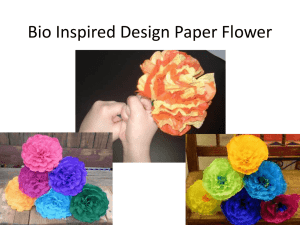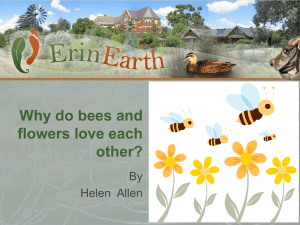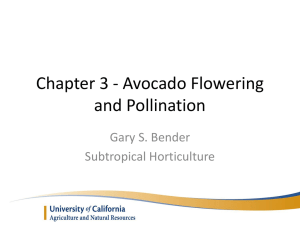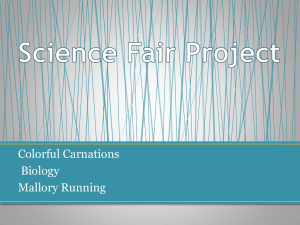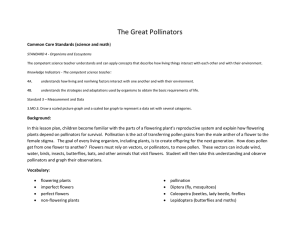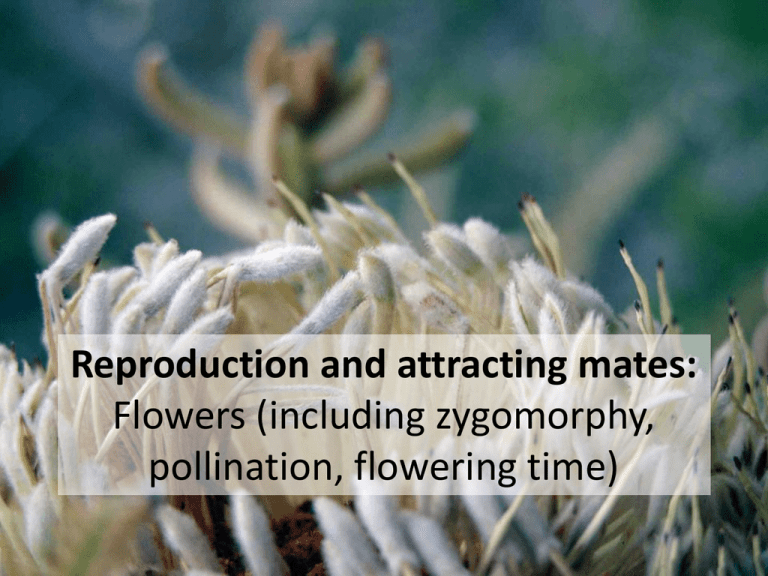
Reproduction and attracting mates:
Flowers (including zygomorphy,
pollination, flowering time)
Questions
• Discussions:
– Maria M: posting paper and questions for this
week
– Jon: will be picking a paper to post for next week
– Peter Stevens is taking students around Orchid
house at gardens at 10 am probably on Saturday.
Let him or me know if you are interested.
• Any questions?
What’s a flower? What’s it for?
Ferns
Gymnosperms
Angiosperms
Flower evolution
• 130-250 mya
– Modified leaves (why?)
What’s a flower?
What’s it for?
• Reproductive structure of
angiosperms:
– Heterosporangiate typically
consisting of androecium,
gynoecium, usually surrounded
by a perianth and borne on an
axis or receptacle
Flower morphology
• Pedicel
• Flower parts in whorls: (4,5’s or 3’s)
– Calyx (sepals), Corolla (petals), Androecium
(stamens with anther, filament), Gynoecium
(pistils with stigma, style, ovary)
Symmetry
• Actinomorphic (radially symmetric) vs
zygomorphic (1 bisecting line of symmetry)
• Asymmetric: uncommon (Cannanceae,
Marantaceae)
Flower vs. Inflorescence
Cercidiphyllum
Breeding systems: outcrossing and
inbreeding
• Spatial:
– Flower: perfect (both sexes) vs. imperfect (1 sex)
– Plant: monoecious (1 sex) vs. dioecious (both
sexes)
– Heterostyly
Breeding systems: outcrossing and
inbreeding
• Temporal: Dichogamy
– Protandry: stamens before carpels
– Protogyny: carpels before stamens
Pollination syndromes
• Animal: Insects, birds, bats
– Rewards: Nectar, pollen, fragrance, oils
– Attract pollinators: Scent, color patterning,
mimicry (Orchidceae)
• Abiotic: Wind and water
• Self pollinated, Cleistogamous
Evolution of oil production and
collection
• Renner and Schaefer. 2010. Phil. Trans. R. Soc.
B. 365:423-435.
– Bees collect oil for larvae and pollinate flowers
– Question: When and how often oil-offering
flowers and oil-foraging bees evolved?
Oil and bees
• Renner and Schaefer. 2010. Phil. Trans. R. Soc.
B. 365:423-435.
– Question: When and how often oil-offering
flowers and oil-foraging bees evolved?
• Oil flowers evolved at least 28 times and lost 36-40
times. Oldest just after the K/T boundary65 mya in
America (Melpighiaceae) and Africa (Curcurbitaceae,
and Laurasia (Myrsinaceae) taxa
• Bees evolved oil foraging at least 7 times with earliest
at least 53-56 Mya (but probably older)
Phylogenies
Build ups
Evolution of floral morphology
Evolution of floral morphology
Question
• Is flower symmetry associated with changes in
speciation rates mediated via pollinators?
Question
• Is flower symmetry associated with changes in
speciation rates mediated via pollinators?
– Suggest bilaterally symmetrical flowers can restrict
pollinator access to flowers, direct pollen
placement, and lead to greater reproductive
isolation
– Predict that bilaterally symmetrical flowers have
higher speciation rates than radially symmetrical
flowers
Question
• Is flower symmetry associated with changes in
speciation rates mediated via pollinators?
– Corolla symmetry data for animal pollinated
families from the literature
– Sister-group comparisons (40 zygomorphic clades
and 19 comparisons)
• Building an angiosperm tree and mapping on
zygomorphy
• Looking for the actinomorphic sister
• Getting number of species in family from literature
Evolution of floral morphology
Zygo-Actino species
* = Actino
† = Zygo
Question
• Is flower symmetry associated with changes in
speciation rates mediated via pollinators?
– In 15/19 comparisons zygomorphic clade was
more diverse than actinomorphic clade


